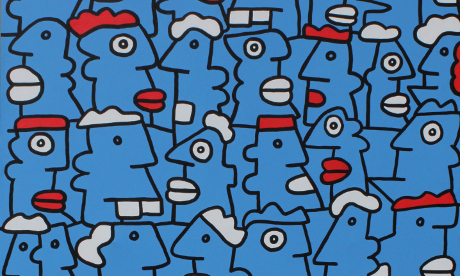Berlin Wall painter Thierry Noir to exhibit in Shoreditch gallery

Details from Blue Fast Form Manifest by Thierry Noir
“The creative scene in London is great, really lively, it feels a bit like Berlin 30 years ago,” enthuses Thierry Noir from his apartment in Berlin, a city once painfully divided by a wall he’s now famous for painting.
As we speak the French-born artist is preparing to travel here for what will be the first retrospective of his work, an exhibition exploring Noir’s life and work through photographs, films and interviews at the Howard Griffin Gallery in Shoreditch.
Noir wasn’t an artist when, like so many before and since, he moved from Lyon to the German captial in 1982 looking to find his way in life.
And in the shadow of the wall that’s exactly what he did, illegally painting block after block of absurd, monstrous heads composed of thick black lines filled with flat planes of bright, near-acidic colour.
It was an action Noir has described as both a spontaneous reaction to the sadness of the situation and a political act of defiance.
“When I first started painting a lot of people were suspicious and would always ask me why,” he explains.
“I was accused of being paid to make the wall beautiful, some sort of government propaganda action, and even of being a spy.”
Attitudes started to change, he says, after the success of the Wim Wenders film Wings of Desire in 1987 featuring a series of his now iconic colour-saturated heads in a largely grey and desolate cinematic landscape.
And then of course the wall, the concrete canvas Noir compared to a bloodthirsty crocodile, a killing machine watching and waiting for prey, fell in 1989.
“For many people the sight of the wall was just unbearable and many wanted to tear it down, get rid of it forever,” Noir says, adding that he’s happy to see segments he once painted in a revolving cast of public and private collections around the world.
And a section of his famous paintings can still be found at Berlin’s East Side Gallery, a previously inaccessible stretch of wall in the former East running along the banks of the River Spree painted by a group of international artists in 1990 as a memorial to freedom.
Protests erupted there in early 2013 after developers secured planning permission to build blocks of luxury apartments and removed two four-foot wall segments to provide access.
For the first time during our conversation Noir’s tone becomes distinctly melancholic as he begins to describe the spectre of a 200-foot tower rising behind his paintings at the memorial.
He tells me how five young children drowned close-by in the late sixties and seventies because rescue services in West Berlin were afraid to enter the water – officially GDR territory – threatened as they were with guns pointed from the heavily guarded border.
“Now they’re building luxury apartments there where those children drowned,” he says incredulously.
“I can only speak for myself but I think they should have made it into a memorial site, a park maybe.”
Berlin is still home for Noir and in just a few weeks time fragments of his life and work will be on display at the Howard Griffin Gallery where the plan is to fill the space with gravel and a replica segment of the wall.
From the street to the gallery, Noir’s bloodthirsty, painted crocodile still has its stories to tell.
Thierry Noir: A Retrospective is at the Howard Griffin Gallery, 189 Shoreditch High Street, E1 6HU from 3 April to 1 May 2014
